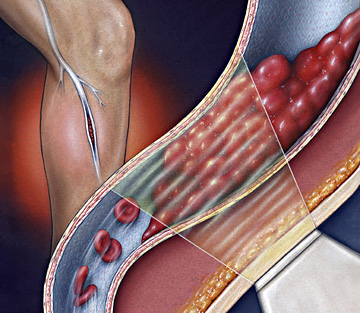 The clotting properties of the blood
The clotting properties of the blood
 An ultrasound scan
An ultrasound scan
 Venography � using x-rays to show the flow of blood when special dye is injected into the veins.
Venography � using x-rays to show the flow of blood when special dye is injected into the veins.
 Plethyesmography of the legs
Plethyesmography of the legs
If a DVT is suspected, the doctor will take a full medical history and carry out a physical examination. Tests that also may be required include:
 The clotting properties of the blood
The clotting properties of the blood
 An ultrasound scan
An ultrasound scan
 Venography � using x-rays to show the flow of blood when special dye is injected into the veins.
Venography � using x-rays to show the flow of blood when special dye is injected into the veins.
 Plethyesmography of the legs
Plethyesmography of the legs

Treatment aims to prevent:
 The clot becoming larger
The clot becoming larger
 The blood clot breaking loose and traveling to the lungs
The blood clot breaking loose and traveling to the lungs
 New clots from forming
New clots from forming
 Post-thrombotic syndrome
Post-thrombotic syndrome

The most common treatment is anticoagulant (blood thinning) medicines which reduce the blood�s tendency to clot. These are usually taken for three to six months. Regular blood tests are needed to check the levels of the drug in the blood. Anticoagulants can stop new blood clots from forming and old ones growing, they can�t dissolve existing clots, and the body does this itself over time. The anticoagulants used are heparin (given through a vein as a �drip� or injected just under the skin twice each day) or warfarin (taken as tablets). Anyone taking these medicines should avoid activities that could in crease the risk of in jury. This is because one of the main ways a wound heals is through clotting, and anticoagulants interfere with this process. Less commonly, clot-dissolving drugs called thrombolytics are used to dissolve a DVT. They carry a high risk of bleeding, so are only used in severe cases, where a life or limb is threatened.

Surgery and some medical treatments can in crease the risk of having a DVT. So, hospitals often do a pre-operative risk assessment for DVT, which takes into account your personal risk factors and the type of surgery you are having. Various measures can then be used to keep the risk as low as possible. These in clued anticoagulant medicines, compression stockings, and an intermittent compression pump. This is a mechanical device that automatically squeezes the feet and lower legs. This helps the circulation of blood from the legs in the first few days after surgery. General preventive advice anyone who feels they are at high risk of developing a DVT should seek medical advice.

 Exercise the legs regularly � take a brisk 30-minute walk every day
Exercise the legs regularly � take a brisk 30-minute walk every day
 Maintain a weight that�s appropriate for your height
Maintain a weight that�s appropriate for your height
 Avoid sitting or lying in bed for long periods of time without moving the legs
Avoid sitting or lying in bed for long periods of time without moving the legs
 Women, particularly those over the age of 30, should consider the risks and benefits of taking the pill
Women, particularly those over the age of 30, should consider the risks and benefits of taking the pill
 Don�t take sleeping pills. These cause immobility, increasing the risk of DVT
Don�t take sleeping pills. These cause immobility, increasing the risk of DVT